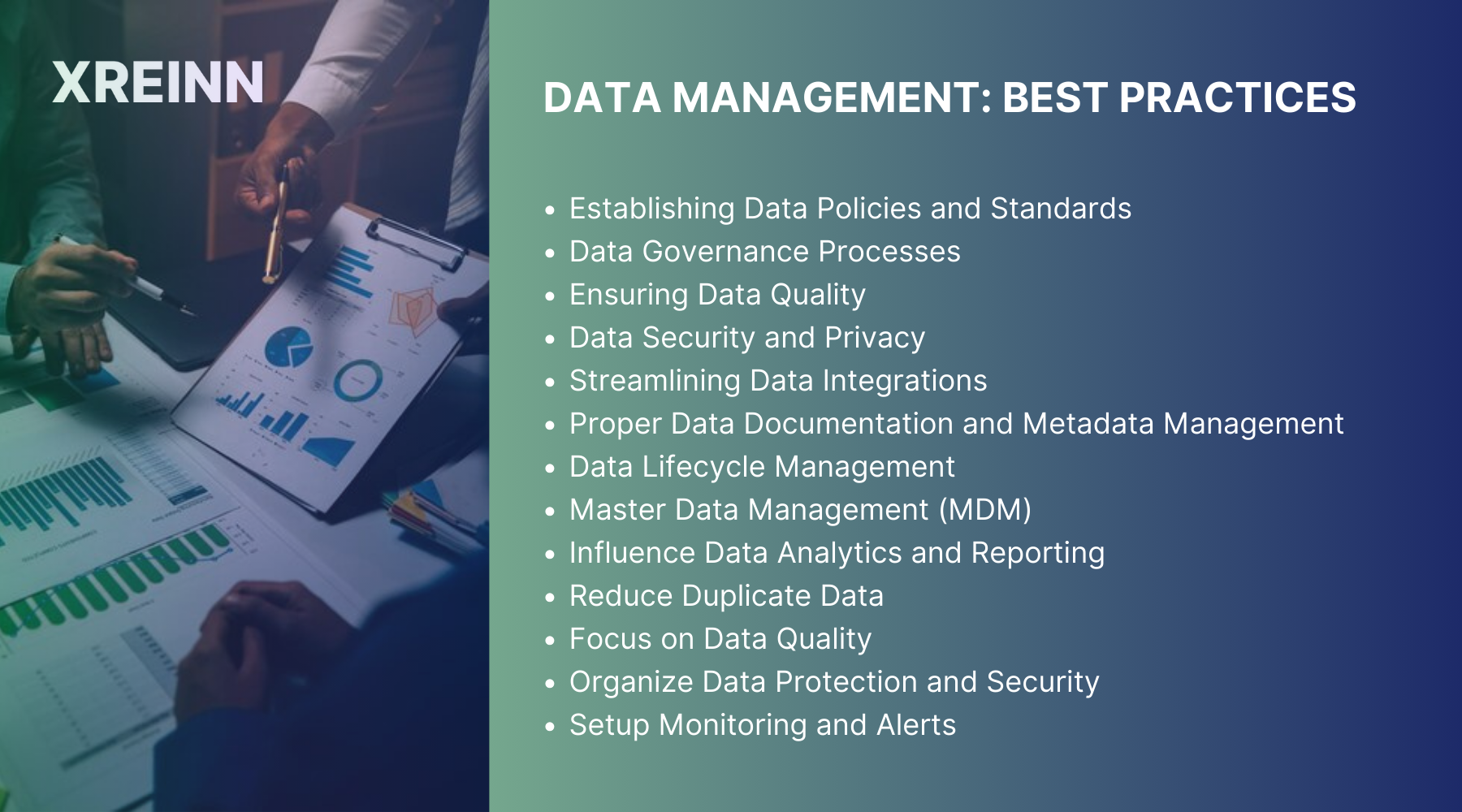Data Integration
13 Best Practices and Tools for Data Management
Aug 02, 2024
Managing your data effectively is essential for any business. It ensures that your data is used securely and efficiently to make decisions and drive actions. This involves a range of tasks such as collecting, combining, cleansing, validating, auditing, and archiving data. Additionally, it's important to protect data security and integrity and to keep data up-to-date, organized, and accessible.
Good data management can help you make better decisions, improve efficiency, and reduce costs by ensuring reliable information is always available. With so many options and methods available, it can be powerful to know where to begin. Here are some data management best practices to help you get started.
What is Data Management?
Data management is the practice of collecting, organizing, and maintaining data processes to ensure its accuracy, accessibility, and security throughout its lifecycle. This involves various activities and methodologies aimed at effectively handling data to meet the needs of an organization, including the development and execution of architectures, policies, practices, and procedures that manage the data lifecycle needs of an enterprise effectively.
Data Management: Key Tools and Practices

1. Establishing Data Policies and Standards
Creating powerful data policies and standards is the foundation of effective data management. Start by developing detailed policies for data collection, storage, access, and usage. These policies ensure all data practices are standardized and compliant with necessary regulations.
For instance, you can use tools like Microsoft Azure Policy to enforce these rules and ensure compliance with regulations such as GDPR and CCPA. Standardizing data formats, naming conventions, and metadata management is also important.
Tools like Apache Avro or JSON Schema can help validate data formats and ensure adherence to established standards.
2. Data Governance Processes
Effective data governance requires well-defined processes to ensure data consistency, quality, and compliance. Classify data based on sensitivity and business value to prioritize protection efforts. Data discovery tools such as Collibra or Informatica can aid in this classification. Additionally, regularly assess data quality through profiling and validation techniques.
Tools like Talend or Trifacta can assist in continuous monitoring and automated data quality checks. Streamline data access requests with structured workflows and role-based access control (RBAC) systems using tools like AWS Identity and Access Management (IAM) or Azure Active Directory to enhance security and compliance.
Ensuring Data Quality
High-quality data is significant for making informed decisions and driving business success. Regular data cleansing sessions help maintain high data quality, and tools like OpenRefine or IBM InfoSphere QualityStage can be invaluable in this process.
Implement continuous monitoring systems to detect and address data quality issues in real time. Automated monitoring solutions like DataRobot or can alert you to potential issues before they escalate, ensuring the reliability of your data.
Data Security and Privacy
Protecting your data from breaches and unauthorized access is more significant. Use advanced encryption standards for data at rest and in transit, with tools like Vormetric Data Security Platform to ensure your data remains secure. Regular security audits using tools like Nessus or Qualys can identify vulnerabilities, while employee training and awareness programs using platforms like KnowBe4 can help mitigate risks of human error leading to data breaches.
Streamlining Data Integrations
Integrating data from various sources is vital for comprehensive analysis and decision-making. Automating data flow between different systems using integration platforms like MuleSoft or Apache Nifi ensures data consistency and accuracy.
Ensuring data is transformed and cleansed to meet your standards before integration is crucial, and tools like Talend or Informatica ETL can facilitate this process. Incorporating validation checks within integration workflows using tools like Apache Kafka or AWS Glue helps detect and rectify errors, enhancing data reliability.
Proper Data Documentation and Metadata Management
Documenting your data sources, definitions, and transformations is important for maintaining data integrity. Tools like Confluence or SharePoint help organize and maintain comprehensive documentation for all data sources, including definitions, transformations, and usage guidelines. Investing in metadata management tools like Alation or Collibra ensures centralized metadata tracking and management, making it easier to understand data lineage and context.
Data Lifecycle Management
Managing the data lifecycle from creation to deletion is essential for compliance and efficiency. Establish clear data retention policies that comply with regulations, using tools like IBM Spectrum Protect to automate these policies and ensure data is retained appropriately.
Automating data archiving and deletion processes with tools like Veeam or Veritas reduces the risk of retaining outdated data and helps manage storage costs. Regularly reviewing and updating data lifecycle policies ensures compliance and data efficiency.
Master Data Management (MDM)
Maintaining consistent and accurate core data is critical for efficient operations. Create a centralized repository for master data using tools like Informatica MDM or SAP Master Data Governance to ensure data consistency across your organization.
Establish governance policies specific to master data, using tools like Collibra, to maintain data integrity. Regular updates and validation of master data with tools like Talend or Alation prevent discrepancies and ensure all systems reflect accurate data.
Influence Data Analytics and Reporting
Advanced analytics and reporting transform data into actionable insights. Invest in advanced data analytics tools like Tableau, Power BI, and QlikView for powerful visualization capabilities that help identify trends and opportunities within your data.
Develop custom dashboards tailored to your business needs, and support this with regular training on these tools to maximize their potential and drive better business outcomes.
Reduce Duplicate Data
While duplicating data can be useful for backup and disaster recovery, excessive duplication leads to redundancy and increased storage costs. Implement manual or automated processes to audit data regularly and remove unnecessary duplicates.
Tools like Deduplication software from Dell EMC or Veritas help manage and reduce duplicate data, keeping your datasets lean and ready for analysis.
Focus on Data Quality
Maintaining high data quality ensures usability and relevance. Continuously validate data accuracy to avoid creating an expensive "data swamp." Tools like Talend Data Quality and Informatica Data Quality automate this process, ensuring only accurate and relevant data is retained. Regularly cleaning and validating real-time data generated by production systems maintains high-quality datasets for business analytics.
Organize Data Protection and Security
Continuously updating your data management strategy to meet current security standards is crucial. Implement access controls using tools like AWS Identity and Access Management (IAM) or Microsoft Azure Active Directory to specify user privileges and prevent credential abuse. Use strong encryption tools like Vormetric Data Security to protect data from unauthorized access, ensuring it remains secure even if accessed by unauthorized individuals.
Setup Monitoring and Alerts
Implement monitoring processes to maintain visibility into data repositories. Use behavioral analysis tools to generate alerts based on deviations from normal behavior, minimizing false positives. These tools help extend your reach and control over large datasets, ensuring that any exceptions are quickly identified and addressed.
Conclusion
Proper data management is essential for any business, helping to improve decision-making, efficiency, and cost-effectiveness. By following the best practices outlined, such as setting clear data policies, maintaining high data quality, and ensuring data security, you can use your data effectively. Streamlining data integration and keeping good documentation will help maintain data integrity.
Managing data throughout its lifecycle and using advanced analytics tools will turn your data into valuable insights. Regularly removing duplicate data and updating security measures will keep your data environment lean and secure.

Data Analytics
Jun 27, 2024Master key concepts in data analytics with practical tips to enhance decision-making and achieve success in your projects and professional growth

Data Analytics
Jul 01, 2024Learn the essential stages of the data analytics workflow to turn your data into valuable business insights and drive growth.

